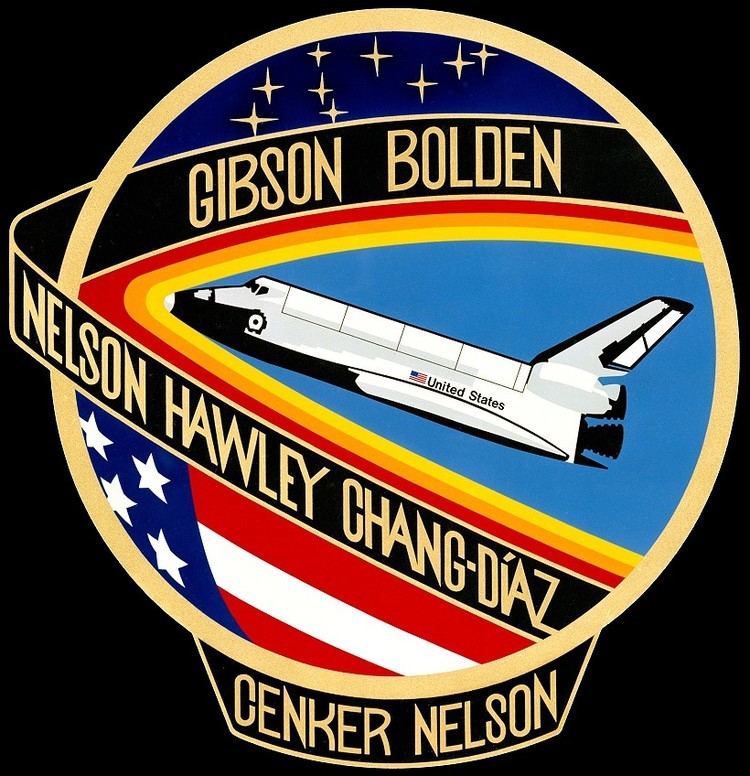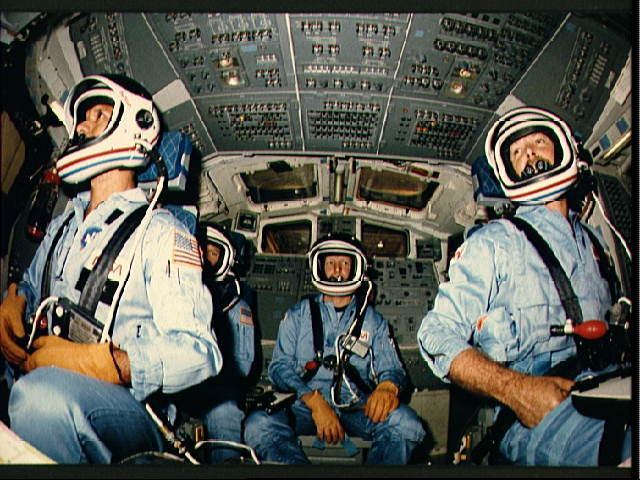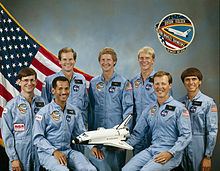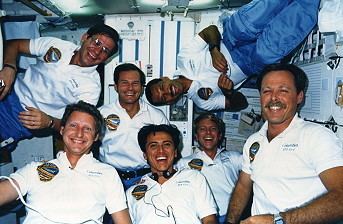COSPAR ID 1986-003A Orbits completed 98 Apogee 338,000 m Landing date 18 January 1986 | SATCAT no. 16481 Period 1.5 hours Launch date 12 January 1986 Dates 12 Jan 1986 – 18 Jan 1986 | |
 | ||
Mission type Satellite deploymentMicrogravity research Mission duration 6 days, 2 hours, 3 minutes, 51 seconds Distance travelled 4,069,481 kilometers (2,528,658 mi) Members Robert L. Gibson, Charles Bolden, George Nelson | ||
Cnn coverage of the launch of sts 61 c
STS-61-C was the twenty-fourth mission of NASA's Space Shuttle program, and the seventh mission of Space Shuttle Columbia. It was the first time that Columbia, the first operational orbiter to be constructed, had flown since STS-9. The mission launched from Florida's Kennedy Space Center on 12 January 1986, and landed six days later on 18 January. STS-61-C's seven-person crew included the second African-American shuttle pilot, future NASA Administrator Charles Bolden, the first Costa Rican-born astronaut, Franklin Chang-Diaz, and the second sitting politician to fly in space, Representative Bill Nelson (D-FL). It was the last shuttle mission before the Space Shuttle Challenger disaster, which occurred just ten days after STS-61-C's landing.
Contents
- Cnn coverage of the launch of sts 61 c
- Cnn coverage of the landing of sts 61 c
- Mission background
- Mission summary
- Wake up calls
- Gag photo
- References

Cnn coverage of the landing of sts 61 c
Mission background

STS-61-C saw Columbia return to flight for the first time since the STS-9 mission in November 1983, after having undergone major modifications over the course of 18 months by Rockwell International in California. Most notable of these modifications was the addition of the SILTS (Shuttle Infrared Leeside Temperature Sensing) pod atop Columbia's vertical stabilizer, which used an infrared camera to observe reentry heating on the shuttle's left wing and part of its fuselage. The camera was only used for a few more missions after STS-61-C, but the pod remained on Columbia for the remainder of its operational life. Smaller and more discreet modifications were also added at various points throughout the shuttle. The bulky ejection seats, which had been safed after STS-4, were replaced with conventional seats and head-up displays for the commander and pilot were installed.

The launch was originally scheduled for 18 December 1985, but the closeout of an aft orbiter compartment was delayed, and the mission was rescheduled for the following day. However, on 19 December, the countdown was stopped at T-14 seconds due to an out-of-tolerance turbine reading on the right SRB's hydraulic system.

Another launch attempt, on 6 January 1986, was terminated at T-31 seconds because of a problem in a valve in the liquid oxygen system. The countdown was recycled to T-20 minutes for a second launch attempt on the same day, but was held at T-9 minutes, and then scrubbed as the launch window expired. Another attempt was made on 7 January, but was scrubbed because of bad weather at contingency landing sites at Dakar, Senegal, and Morón, Spain; yet another attempt, on 9 January, was delayed because of a problem with a main engine prevalve, and on 10 January, heavy rainfall in the launch area led to another scrub.
Mission summary

After four unsuccessful launch attempts, Columbia launched successfully from Kennedy Space Center at 6:55 am EST on 12 January 1986. There were no significant anomalies reported during the launch.
The primary objective of the mission was to deploy the Satcom K1 communications satellite, second in a planned series of geosynchronous satellites owned and operated by RCA Americom; the deployment was successful. Columbia also carried a large number of small scientific experiments, including 13 Getaway Special (GAS) canisters devoted to investigations involving the effect of microgravity on materials processing, seed germination, chemical reactions, egg hatching, astronomy, atmospheric physics, and an experiment designed by Ellery Kurtz and Howard Wishnow of Vertical Horizons to determine the effects of the space environment on fine arts materials and original oil paintings. Also carried was a Materials Science Laboratory-2 structure for experiments involving liquid bubble suspension by sound waves, melting and resolidification of metallic samples and container-less melting and solidification of electrically conductive specimens. Another small experiment carrier located in the payload bay was the Hitchiker G-1 (HHG-1), which carried three experiments to study film particles in the orbiter environment, test a new heat transfer system and determine the effects of contamination and atomic oxygen on ultraviolet optics materials, respectively. There were also four in-cabin experiments, three of them part of the Shuttle Student Involvement Program. The shuttle carried an experiment called the Comet Halley Active Monitoring Program (CHAMP), consisting of a 35 mm camera intended to photograph Halley's Comet through the aft flight deck overhead window. This experiment proved unsuccessful because of battery problems.
According to Bolden, in addition to deploying the RCA satellite, Cenker operated a classified experiment for the United States Air Force during the mission. Bolden was only told that it was a prototype for an infrared imaging camera.
STS-61-C was originally scheduled to last seven days, but NASA decided to end it after four because its delays had delayed the next flight, STS-51-L. It was rescheduled to land on 17 January, but this was brought forward by one day. However, the landing attempt on 16 January was cancelled because of unfavorable weather at Edwards Air Force Base. Continued bad weather forced another wave-off the following day. The flight was extended one more day to provide for a landing opportunity at Kennedy Space Center on 18 January – this was in order to avoid time lost in an Edwards AFB landing and turnaround. However, bad weather at the KSC landing site resulted in yet another wave-off.
Columbia finally landed at Edwards AFB on its fifth landing attempt at 5:59 am PST, on 18 January. The mission lasted a total of 6 days, 2 hours, 3 minutes, and 51 seconds. STS-61-C was the last successful Space Shuttle flight before the Challenger disaster, which occurred on 28 January 1986, only 10 days after Columbia's return. Accordingly, commander Gibson later called the STS-61-C mission "The End of Innocence" for the Shuttle Program.
Nelson, the Florida congressman, had hoped to receive a Florida orange after landing in the state. The personnel at Edwards greeted the crew with what Bolden described as "a peck basket of California oranges and grapefruits".
Wake-up calls
NASA began a tradition of playing music to astronauts during the Gemini program, and first used music to wake up a flight crew during Apollo 15. Each track is specially chosen, often by the astronauts' families, and usually has a special meaning to an individual member of the crew, or is applicable to their daily activities.
Gag photo
During the same session as the official crew photo, the NASA photographer took a gag photo of the STS-61-C crew with their heads and faces obscured by their helmets and visors.
